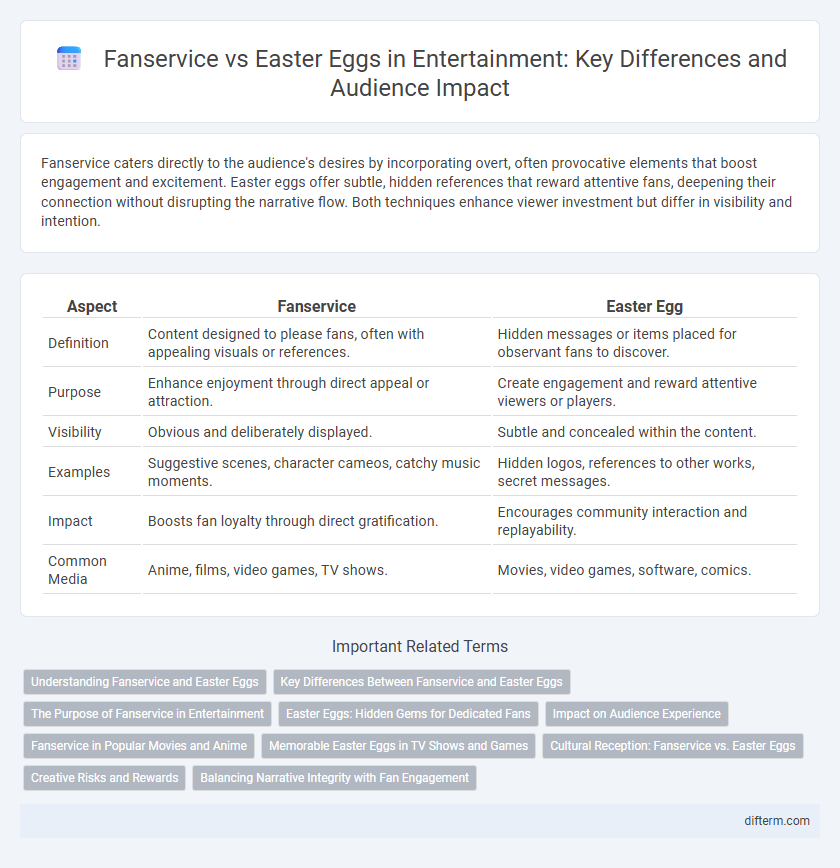Fanservice caters directly to the audience's desires by incorporating overt, often provocative elements that boost engagement and excitement. Easter eggs offer subtle, hidden references that reward attentive fans, deepening their connection without disrupting the narrative flow. Both techniques enhance viewer investment but differ in visibility and intention.
Table of Comparison
| Aspect | Fanservice | Easter Egg |
|---|---|---|
| Definition | Content designed to please fans, often with appealing visuals or references. | Hidden messages or items placed for observant fans to discover. |
| Purpose | Enhance enjoyment through direct appeal or attraction. | Create engagement and reward attentive viewers or players. |
| Visibility | Obvious and deliberately displayed. | Subtle and concealed within the content. |
| Examples | Suggestive scenes, character cameos, catchy music moments. | Hidden logos, references to other works, secret messages. |
| Impact | Boosts fan loyalty through direct gratification. | Encourages community interaction and replayability. |
| Common Media | Anime, films, video games, TV shows. | Movies, video games, software, comics. |
Understanding Fanservice and Easter Eggs
Fanservice refers to content intentionally designed to please the audience by highlighting popular characters or appealing visuals, often enhancing viewer engagement. Easter eggs are subtle, hidden references or inside jokes embedded within media for attentive fans to discover, adding layers of depth and connection. Both elements enrich the entertainment experience by fostering fan interaction and rewarding close attention.
Key Differences Between Fanservice and Easter Eggs
Fanservice targets fans directly through suggestive or appealing content designed to enhance viewer satisfaction, often emphasizing character interactions or visual elements to provoke excitement. Easter eggs are subtle, hidden references or inside jokes embedded within a work, rewarding attentive or knowledgeable fans without altering the main narrative. The key difference lies in fanservice's explicit aim to attract and entertain the audience, whereas easter eggs serve as clever, often unobtrusive nods that enrich the viewing experience.
The Purpose of Fanservice in Entertainment
Fanservice in entertainment aims to directly engage and satisfy the audience by including content specifically designed to please fans, such as suggestive scenes or character interactions. Unlike Easter eggs, which serve as subtle nods or hidden references, fanservice often enhances viewer enjoyment through explicit visual or narrative elements. This targeted approach helps maintain fan loyalty and boosts audience retention by catering to popular preferences within a franchise.
Easter Eggs: Hidden Gems for Dedicated Fans
Easter eggs in entertainment serve as hidden gems that reward dedicated fans with subtle references, inside jokes, or secret content, enriching the overall experience without interrupting the narrative. Unlike fanservice, which often aims to appeal broadly or superficially, Easter eggs deepen engagement by encouraging viewers to actively seek out and interpret these clever nods. Examples include hidden symbols in films, obscure character cameos, or cryptic messages that connect across a franchise's universe, fostering a loyal and attentive fanbase.
Impact on Audience Experience
Fanservice enhances audience engagement by directly appealing to dedicated fans with familiar characters or scenes, creating a sense of inclusion and excitement. Easter eggs offer subtle, hidden references that reward attentive viewers and foster a deeper connection through discovery and shared insider knowledge. Both elements influence audience experience by balancing immediate gratification with long-term appreciation, shaping emotional investment and community interaction.
Fanservice in Popular Movies and Anime
Fanservice in popular movies and anime often includes visually appealing scenes, character interactions, or references designed to excite dedicated fans and enhance viewer engagement. Unlike subtle Easter eggs that reward attentive audiences with hidden references, fanservice explicitly targets fan desires through suggestive content or familiar tropes. Titles like "Dragon Ball Z" and "Deadpool" frequently utilize fanservice to maintain lasting fan loyalty and boost commercial success.
Memorable Easter Eggs in TV Shows and Games
Memorable Easter eggs in TV shows and games enrich the entertainment experience by rewarding dedicated fans with hidden references and insider nods, such as the iconic "Red Rum" clue in Stephen King's *The Shining* adaptation or the hidden Mega Man helmet in *Call of Duty: Infinite Warfare*. Unlike fanservice, which often caters explicitly to audience desires for appeal or gratification, Easter eggs deepen narrative layers and encourage replayability, creating a lasting impact on fan communities. These subtle inclusions not only enhance viewer or player engagement but also elevate the cultural significance of the media by celebrating shared knowledge and fandom history.
Cultural Reception: Fanservice vs. Easter Eggs
Fanservice and easter eggs both enrich entertainment experiences but differ significantly in cultural reception. Fanservice, often explicit and targeted to satisfy audience desires, can provoke polarized opinions due to perceptions of objectification or pandering. Easter eggs, subtle hidden references, tend to be celebrated for their cleverness and reward dedicated fans, fostering deeper engagement without overt controversy.
Creative Risks and Rewards
Fanservice often involves overt creative risks by directly catering to audience desires, which can enhance viewer engagement but may alienate some fans if overused or perceived as pandering. Easter eggs present subtler creative risks through hidden references that reward attentive fans with deeper lore connections, boosting community interaction and long-term franchise loyalty. Balancing fanservice with cleverly integrated easter eggs cultivates a rich entertainment experience that maximizes fan investment without compromising artistic integrity.
Balancing Narrative Integrity with Fan Engagement
Balancing narrative integrity with fan engagement requires careful integration of fanservice and Easter eggs, ensuring that fanservice enhances rather than detracts from the story's coherence. Easter eggs serve as subtle nods to devoted fans, enriching the viewing experience without disrupting plot progression. Effective entertainment maintains story immersion while rewarding loyal audiences with meaningful, contextually appropriate content.
fanservice vs easter egg Infographic

 difterm.com
difterm.com